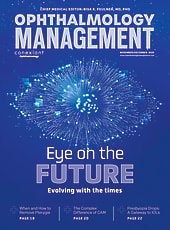The 2025, CPT Handbook contains a new procedure code for reporting OCT angiography (OCTA). This is a welcome addition to the list of codes for retinal scanning diagnostic services. The complete definition of the code is:
92137 Computerized ophthalmic diagnostic imaging (eg, optical coherence tomography), anterior segment with interpretation and report, unilateral or bilateral; retina, including OCT angiography
What Is OCTA?
OCTA provides a high resolution, non-invasive diagnostic image of the vessels of the retina and choroid in cases of retinal vascular pathology due to neovascularization, nonperfusion, microaneurysms, or vascular abnormalities.1
Optical coherence tomography (OCT) provides image slices of tissue using near-infrared light. With x, y, and z axes for reference, OCTA improves on older OCT technology because it provides en face transversal sections (C-scans) where traditional OCT provides only longitudinal sections (B-scans).
The injection of dye, which is used in traditional ocular angiograms, is not needed for this test. Instead, OCTA uses the principle of diffractive particle movement of moving red blood cells to determine vessel location through various segments of the eye without the need for intra-vascular dyes.2 Without injections of dye, the test is safer, faster, and has fewer risks of adverse reactions.3 OCTA is used to diagnose and monitor conditions in the retina, optic nerve, uveitis, and neurology.4
What Are Some Indications?
Retinal indications include: diabetic retinopathy, age-related macular degeneration (dry and wet AMD), central serous retinopathy, choroidal neovascular membranes, vascular occlusions and macular telangiectasia.
Optic nerve indications include the vascular factors that contribute to glaucoma development and progression, arteritic ischemic optic neuropathy (AION), and optic neuritis.
Uveitis indications include inflammatory vasculitis, birdshot chorioretinopathy, cystoid macular edema and inflammation of the choriocapillaris.
In neurology, indications include Alzheimer’s disease and other forms of dementia.5 The indications described here are representative but not an exhaustive list.
Because CPT code 92137 is so new, there is very little information regarding covered diagnosis codes (ICD-10-CM). At the time of this writing, only 2 Medicare Administrative Contractors had updated Local Coverage Articles (LCAs) online: First Coast Solutions6 and Novitas.7
How Do I Document This Test?
Like other ophthalmic diagnostic tests, thorough documentation is required. A brief notation such as “abnormal” test finding does not suffice. An adequate chart note includes:
- An order for the test with medical rationale
- The date of the test
- The reliability of the test
- The test findings (eg, vessel obstruction)
- Comparison with prior OCTA tests
- A diagnosis (if possible)
- The impact on treatment and prognosis
- The signature of the physician
Be sure to document the location of the images if they are stored separately from the medical record.
How Does Payment Work?
Although payors have not yet provided detailed instructions, CPT does give some guidance. CPT instructs, do not report 92137 on the same date of service as 92133 or 92134.8
Because there are so few policies or instructions from payors, it may be difficult to determine how the payor will respond to your claim. When coverage is uncertain, the patient may be responsible for payment. Explain why the test is necessary, and that Medicare or other third-party payors will likely deny the claim. Ask the patient to assume financial responsibility for the charge, use the appropriate form for the payor involved.
• An Advance Beneficiary Notice of Noncoverage (ABN) (https://www.cms.gov/medicare/forms-notices/beneficiary-notices-initiative/ffs-abn) is required for services where Part B Medicare coverage is uncertain, and may be useful where a service is never covered. You may collect your fee from the patient at the time of service or wait for a Medicare denial. If both the patient and Medicare pay, promptly refund the patient or show why Medicare paid in error.
• For Part C Medicare (Medicare Advantage), determination of benefits is required to identify beneficiary financial responsibility prior to performing noncovered services; MA Plans have their own waiver forms and processes.
• For commercial insurance beneficiaries, a Notice of Exclusion from Health Plan Benefits (NEHB) (https://corcoranccg.com/nehb-notice-of-exclusion-from-health-plan-benefits-generic/) is an alternative to an ABN.
The 2025 national, unadjusted Medicare Physician Fee Schedule allowable is $57. Of this amount, $23 is assigned to the technical component of the test, and $34 to the professional component (ie, interpretation). Actual payment rates vary by locality. The code is defined by Medicare as bilateral. This payment rate applies for one or both eyes.
Other payers set their own rates, which may differ significantly from the Medicare published fee schedule.
OCTA is subject to Medicare’s Multiple Procedure Payment Reduction (MPPR). This reduces the allowable for the technical component of the lesser-valued test when more than one test is performed on the same day.
Conclusion
CPT periodically introduces new CPT codes to identify new or changing technologies. Take a few minutes to familiarize yourself with instructions surrounding the new code—coverage, payment rates, claims instructions and payment rates for these codes. Also, monitor their use until you are comfortable with your staff’s understanding and have paid claims to show the payors are processing. OP
References
1. Koustenis A Jr, Harris A, Gross J, Januleviciene I, Shah A, Siesky B. Optical coherence tomography angiography: an overview of the technology and an assessment of applications for clinical research. Br J Ophthalmol. 2017;101(1):16-20. doi:10.1136/bjophthalmol-2016-309389. https://pubmed.ncbi.nlm.nih.gov/27707691/. Accessed December 11, 2024.
2. Leitgeb RA. En face optical coherence tomography: a technology review [Invited]. Biomed Opt Express. 2019;10(5):2177-2201. Published Apr 3, 2019. doi:10.1364/BOE.10.002177. https://opg.optica.org/boe/fulltext.cfm?uri=boe-10-5-2177&id=408186. Accessed December 11, 2024.
3. Le PH, Kaur K, Patel BC. Optical Coherence Tomography Angiography. In: StatPearls. Treasure Island (FL): StatPearls Publishing; October 6, 2024. https://www.ncbi.nlm.nih.gov/books/NBK563235. Accessed December 11, 2024.
4. AAO EyeWiki. Optical coherence tomography angiography. https://eyewiki.org/Optical_Coherence_Tomography_Angiography. Accessed December 11, 2024.
5. Rifai OM, McGrory S, Robbins CB, et al. The application of optical coherence tomography angiography in Alzheimer’s disease: A systematic review. Alzheimers Dement (Amst). 2021;13(1):e12149. Published 2021 Mar 3. doi:10.1002/dad2.12149. https://alz-journals.onlinelibrary.wiley.com/doi/full/10.1002/dad2.12149. Accessed December. 11, 2024.
6. First Coast Solutions (https://tinyurl.com/3zs88eys)
7. Novitas Solutions Medicare Administrative Contractor (https://tinyurl.com/56fseyp4)
8. 2025 CPT Professional Edition









